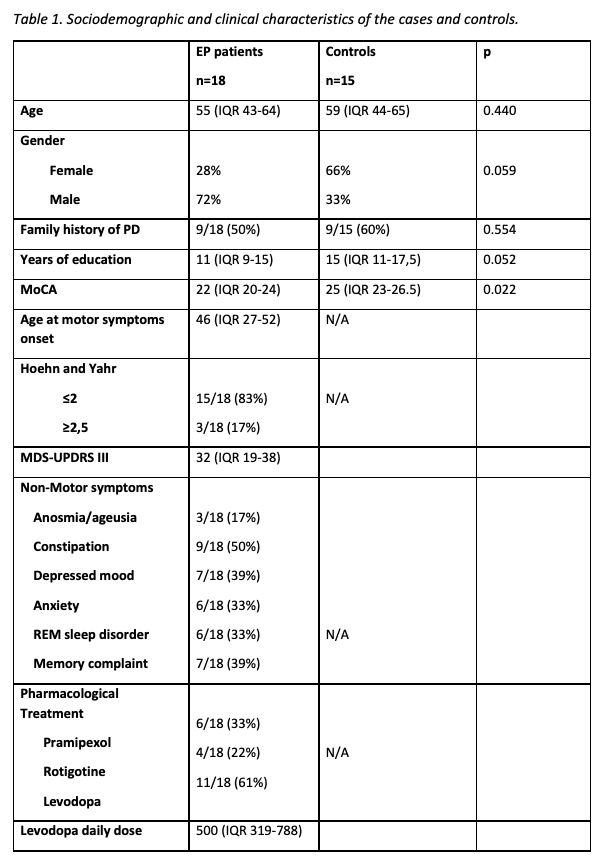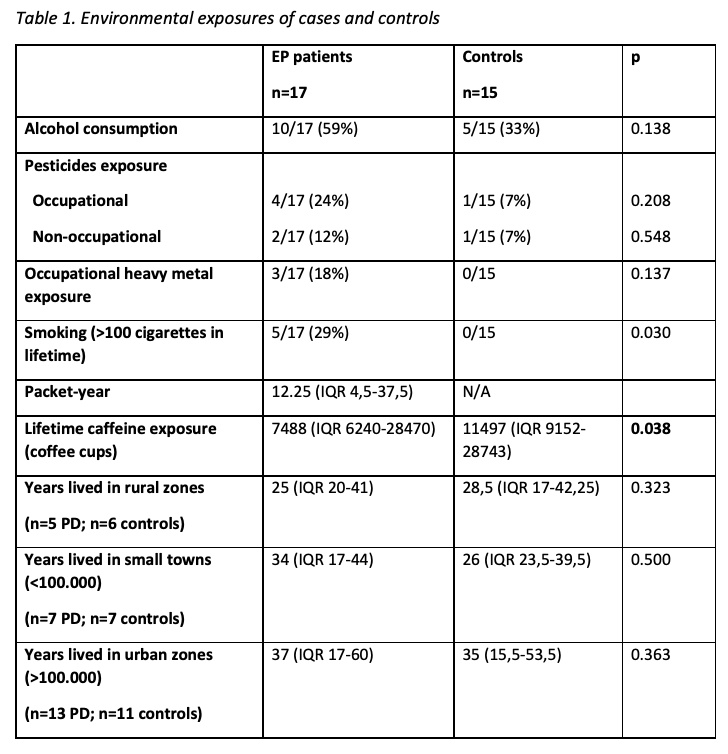Category: Technology
Objective: Describe the clinical characteristics, environmental exposures, and technology-based gait assessment of a sample of Parkinson’s disease patients in a rural area in southwestern of Colombia.
Background: Although monogenic Parkinson’s disease has been described, it is globally accepted as a multifactorial disease(1). Southwestern Colombia is a region characterized by the convergence of inbreeding in small rural towns, agriculture, metal exposures and scarce access to specialized medicine. RGB-D cameras are low cost user-friendly devices with a high potential to obtain objective gait measures(2)in rural areas as a complement for clinical evaluation.
Method: A case-control study was conducted within the framework of the LARGE-PD consortium. A Multidisciplinary brigade was organized in Province of Nariño (Colombia). A movement disorder specialist evaluated the patients. A structured questionnaire for environmental exposure, MoCA, NMSQuest and a pedigree were obtained. The RGB-D camera (Kinect®) coupled to a signal processing system (e-Motion) was performed. All of patients were in ON state.
Results: 18 patients with PD and 15 healthy controls were included. Age for PD patients was 55(43-64),72% were males. Age at motor symptom onset was 46(27-52),84% were on early stages (H&Y ≤ 2),50% had family history of PD. MDS-UPDRS III was 32(19-38. MoCA score in PD group was 22(20-24) constipation was the most frequent NMS (50%)(table1). No differences were found for occupational and non-occupational pesticides exposure (p=0,208 p=0.548 respectively); heavy metal exposures(p=0.137). Controls had more caffeine exposure trough their life(p=0,0384) (table2). Differences were found for left leg swing time(p=0.0384), left leg stance time(p=0.0351), left and right number of steps(p=0.0287) and step length(p=0.0041). No differences were found on arm swing gait variables.
Conclusion: Nariño is an important region of patients with early-onset PD, MCI and high family history of PD. Healthy controls had a higher caffeine exposure which has been described as a protector factor against PD(3). RGB-D cameras are low-cost portable devices that allow rural use, also can detect gait differences between healthy controls and PD even in small groups and early stages of the disease, serving as a diagnostic complement in regions where there is scarce access to specialized medicine.
References: 1. Ball N, Teo W-P, Chandra S, Chapman J. Parkinson’s Disease and the Environment. Front Neurol. 2019 Mar 19;10:218.
2. Muñoz Ospina B, Valderrama Chaparro JA, Arango Paredes JD, Castaño Pino YJ, Navarro A, Orozco JL. Age Matters: Objective Gait Assessment in Early Parkinson’s Disease Using an RGB-D Camera. Park Dis. 2019 Jun 13;2019:1–9.
3. Ren X, Chen J-F. Caffeine and Parkinson’s Disease: Multiple Benefits and Emerging Mechanisms. Front Neurosci. 2020 Dec 17;14:602697.
4. Zifchock RA, Davis I, Higginson J, Royer T. The symmetry angle: A novel, robust method of quantifying asymmetry. Gait Posture. 2008 May;27(4):622–7.
To cite this abstract in AMA style:
B. Muñoz-Ospina, H. Clavijo-Moran, D. álvarez-García, A. Navarro Cadavid, I. F Mata, J. Orozco Velez. Clinical, environmental, and Technology-based gait measures in PD patients from a rural area in southwestern Colombia: a case-control pilot study [abstract]. Mov Disord. 2022; 37 (suppl 2). https://www.mdsabstracts.org/abstract/clinical-environmental-and-technology-based-gait-measures-in-pd-patients-from-a-rural-area-in-southwestern-colombia-a-case-control-pilot-study/. Accessed November 7, 2025.« Back to 2022 International Congress
MDS Abstracts - https://www.mdsabstracts.org/abstract/clinical-environmental-and-technology-based-gait-measures-in-pd-patients-from-a-rural-area-in-southwestern-colombia-a-case-control-pilot-study/


